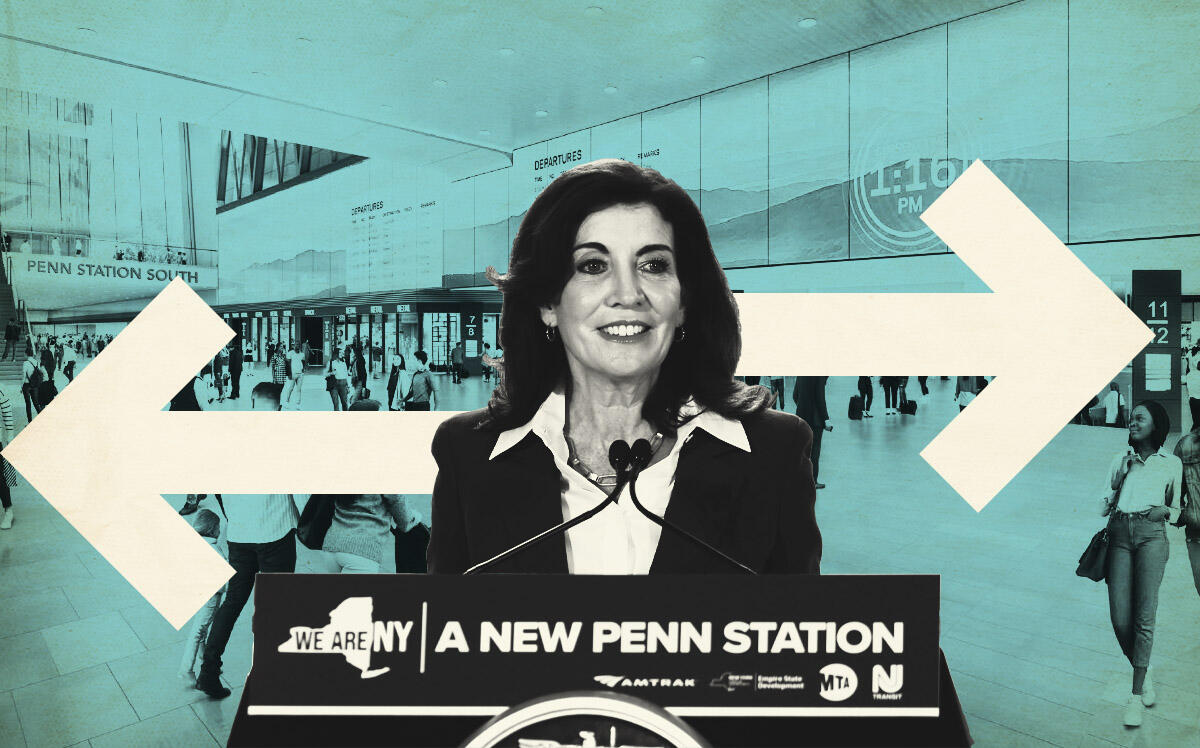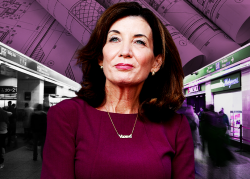 Comeback kids: Related, Vornado win bid for Moynihan Train Hall redevelopment project
Comeback kids: Related, Vornado win bid for Moynihan Train Hall redevelopment project
Trending
Hochul advances Penn redesign, but district’s future remains cloudy
Governor issues request for proposals, due next month

The state advanced the $7 billion redesign of Penn Station Thursday, though the fate of the redevelopment of the neighborhood itself is still uncertain.
Gov. Kathy Hochul announced that the state will begin accepting bids from architecture and engineering firms for the redesign of the station. Proposals are due July 28 and a winner will be selected in the fall, she said.
As part of the project, the station’s upper level will be removed to create a 250,000-square-foot, single-level facility. Hochul said the transformation will be “physical and spiritual,” creating a light-filled station in place of what elected officials have repeatedly compared to hell.
“We will return this station to its former glory,” Hochul said during a press conference on Thursday, alluding to the transit hub’s previous iteration, which was torn down to make way for Madison Square Garden. The arena has since 1968 rendered the station below a dungeon-like, column-filled labyrinth.
The governor noted that a 460-foot atrium and skylight would assure commuters that “the heavens are out there still, despite the feeling that you may be living in hell.”
In November, Hochul announced that the state would shift its focus to the overhaul of existing Penn, putting on ice a plan to add eight tracks to the south of the station. The expansion on West 31st Street would require the demolition of 50-plus properties and the use of eminent domain should any owner not agree to sell.
She also slightly downsized what was proposed by her predecessor, Andrew Cuomo, and added affordable housing to some of the towers.
The governor reiterated Thursday that the redesign will rely on revenue generated by the development of 10 new towers on eight sites surrounding the station — a plan not fully formed.
Empire State Development is expected to vote on the general project plan for that development this summer. Vornado Realty Trust, which has amassed more than 9 million square feet around Penn since the 1990s, is expected to develop most of the 18 million-plus square feet of new office space.
Read more
 Comeback kids: Related, Vornado win bid for Moynihan Train Hall redevelopment project
Comeback kids: Related, Vornado win bid for Moynihan Train Hall redevelopment project
 Hochul vows to work with mayor, punts on Penn Station details
Hochul vows to work with mayor, punts on Penn Station details
Opponents and city officials have raised concerns about how these projects will be financed. City and state officials are negotiating for payments in lieu of taxes, or PILOTs, and the state will then reach individual deals with Vornado and other property owners before their sites are developed.
The state expects the planned Gateway tunnels under the Hudson River, the Penn expansion and renovation projects to cost $30 billion to $40 billion, with New York picking up 25 percent of that. The state has already committed about $5 billion (or roughly half of the $7 to $10 billion it will need to spend). The gap of $2 billion to $5 billion would be filled by PILOTs from the new buildings and yet-to-be-determined sources such as tax-exempt bonds or federal loans.
The redesign includes a concourse that would be larger than Moynihan Train Hall and the Great Hall at Grand Central Terminal combined. But the hall is envisioned for a block-long area that includes a defunct taxiway owned by MSG Entertainment. Politico reported that the state must acquire the interest in the taxiway in order to build the hall. State officials did not immediately comment on the status of those negotiations.
Plans to redevelop Penn Station have had several false starts over the past two decades. On Thursday, Hochul touted New York’s collaboration with various agencies and with the state of New Jersey to signal its likely success this time. Mayor Eric Adams and New Jersey Gov. Phil Murphy also spoke in favor of the project at the press conference.
“For too long, Penn Station has been outdated and inefficient, and for too long, petty disagreements have gotten in the way of progress,” Adams said in a statement. “I am so pleased that these partners have come together and are working constructively to get this project done for New York City.”
The mayor has been trying to put to rest concerns about a city-state divide that arose from his administration’s questions about project financing and its impact on the city’s property tax revenue. PILOTs divert money that would otherwise go to the city’s coffers.
Hochul also announced the creation of a task force charged with planning out public realm improvements, including redesigned streets and new open space around the station.




